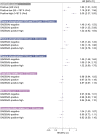Interaction between plasma phospholipid odd-chain fatty acids and GAD65 autoantibodies on the incidence of adult-onset diabetes: the EPIC-InterAct case-cohort study
- PMID: 37301794
- PMCID: PMC10317878
- DOI: 10.1007/s00125-023-05948-x
Interaction between plasma phospholipid odd-chain fatty acids and GAD65 autoantibodies on the incidence of adult-onset diabetes: the EPIC-InterAct case-cohort study
Abstract
Aims/hypothesis: Islet autoimmunity may progress to adult-onset diabetes. We investigated whether circulating odd-chain fatty acids (OCFA) 15:0 and 17:0, which are inversely associated with type 2 diabetes, interact with autoantibodies against GAD65 (GAD65Ab) on the incidence of adult-onset diabetes.
Methods: We used the European EPIC-InterAct case-cohort study including 11,124 incident adult-onset diabetes cases and a subcohort of 14,866 randomly selected individuals. Adjusted Prentice-weighted Cox regression estimated HRs and 95% CIs of diabetes in relation to 1 SD lower plasma phospholipid 15:0 and/or 17:0 concentrations or their main contributor, dairy intake, among GAD65Ab-negative and -positive individuals. Interactions between tertiles of OCFA and GAD65Ab status were estimated by proportion attributable to interaction (AP).
Results: Low concentrations of OCFA, particularly 17:0, were associated with a higher incidence of adult-onset diabetes in both GAD65Ab-negative (HR 1.55 [95% CI 1.48, 1.64]) and GAD65Ab-positive (HR 1.69 [95% CI 1.34, 2.13]) individuals. The combination of low 17:0 and high GAD65Ab positivity vs high 17:0 and GAD65Ab negativity conferred an HR of 7.51 (95% CI 4.83, 11.69), with evidence of additive interaction (AP 0.25 [95% CI 0.05, 0.45]). Low dairy intake was not associated with diabetes incidence in either GAD65Ab-negative (HR 0.98 [95% CI 0.94, 1.02]) or GAD65Ab-positive individuals (HR 0.97 [95% CI 0.79, 1.18]).
Conclusions/interpretation: Low plasma phospholipid 17:0 concentrations may promote the progression from GAD65Ab positivity to adult-onset diabetes.
Keywords: Diabetes; GAD65Ab; Heptadecanoic; Islet autoimmunity; OCFA; Pentadecanoic.
© 2023. The Author(s).
Figures


References
-
- Zheng J-S, Sharp SJ, Imamura F, et al. Association between plasma phospholipid saturated fatty acids and metabolic markers of lipid, hepatic, inflammation and glycaemic pathways in eight European countries: a cross-sectional analysis in the EPIC-InterAct study. BMC Med. 2017;15(1):203. doi: 10.1186/s12916-017-0968-4. - DOI - PMC - PubMed
Publication types
MeSH terms
Substances
Grants and funding
LinkOut - more resources
Full Text Sources
Medical

